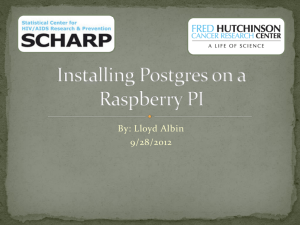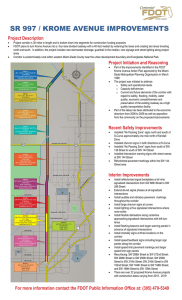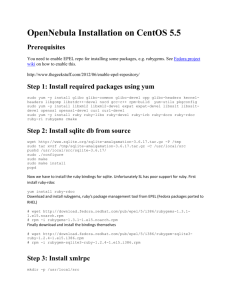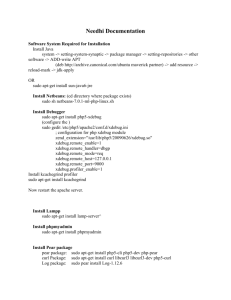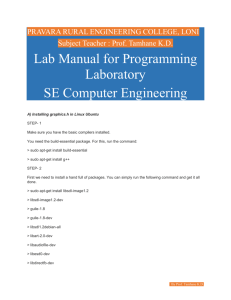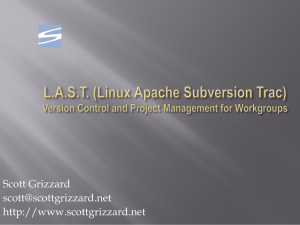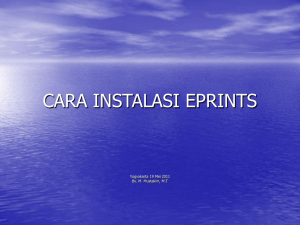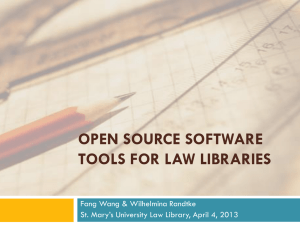slides - Yin Lab @ NIU
advertisement
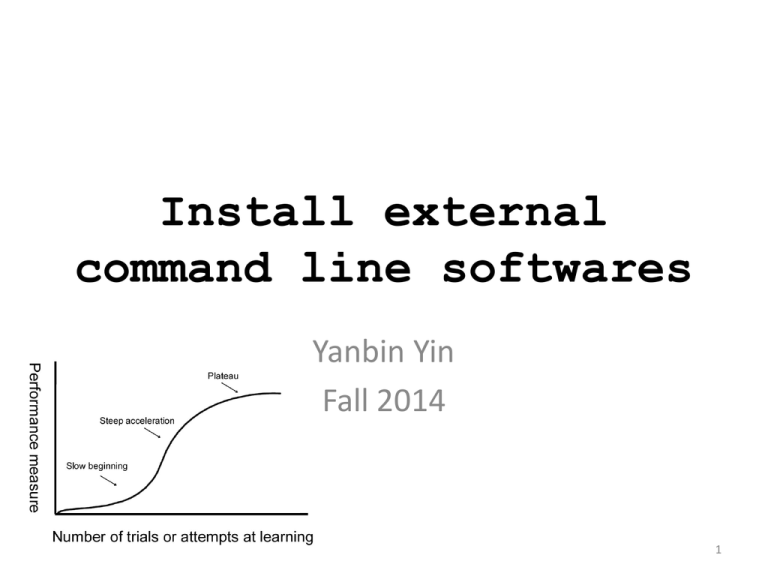
Install external command line softwares Yanbin Yin Fall 2014 1 Homework #8 Create a folder under your home called hw8 Change directory to hw8 Copy the faa file and ptt file you’ve downloaded from NCBI ftp site in hw7 to hw8 folder Create unix one-liner (piping different commands) to count how many proteins are there in the faa file and save the protein gi numbers (just the gi) in a file Create unix one-liner (piping different commands) to process the ptt file and count how many genes are located in the positive strand and how many in the negative strand Write a report (in word or ppt) to include all the operations/commands and screen shots. Office hour: Due on Nov 24 (send by email) Tue, Thu and Fri 2-4pm, MO325A 2 Or email: yyin@niu.edu Programs/tools we often use • • • • • • • BLAST FASTA HMMER EMBOSS lftp bioperl R • • • • • • • • • • Clustalw MAFFT MUSCLE SRA toolkit weblogo PhyML FastTree RaxML USEARCH ... http://gacrc.uga.edu/ 3 On WINDOWS, you download some softwares usually in exe format. You double click on some icon and windows installer will do the rest for you. Usually you will be asked: where you want to have this program installed to (C:\WINDOWS\Programs\) On Linux, it’s very different. You download the software package, usually in compressed format (.gz or .zip). You have to type in a series of commands to install it, often write it to a system folder (e.g. /usr/bin), which you don’t have access unless you are the root user 4 Linux-based program types • Source codes in C, C++, Java, Fortran etc. – Need to be compiled before execute the command • Precompiled executables or binary codes • Source codes in scripting languages (perl, python, R etc.) – Can execute directly Many programs need dependencies (if order to install program A, you need install B first …) 5 On your own ubuntu machine … Not on Ser • You are the root (administrator) and using the sudo command you can install anything you want into the system directory (/usr/bin/, /bin/, /lib/ etc.) – apt-get (Advanced Packaging Tool) can do many installations for you from source or binary codes https://help.ubuntu.com/12.04/serverguide/apt-get.html • On Ser, you are not the root and you can only install things under your home using the “hard” way – Download->unpack->install->edit PATH environmental variable – Make sure you create folders for each tools, e.g. yourhome/tools/fasta 6 Install BLAST on your own machine Not on Ser [test if installed] sudo apt-get install blast2 [test if installed] blastall [where it installed] which blastall [if you want to uninstall] sudo apt-get remove blast2 [test if it’s gone] blastall [new version of blast] sudo apt-get install ncbi-blast+ 7 Use apt-get to install lftp, emboss, hmmer, bioperl, clustaw, muscle, R sudo apt-get install xxx [to test if installed, type in the command] 8 On your own MAC http://www.digimantra.com/howto/apple-aptget-command-mac/ http://superuser.com/questions/173088/apt-get-on-mac-os-x http://www.macobserver.com/tmo/article/install_the_command_line _c_compilers_in_os_x_lion Install Xcode, then C compiler, then you can install Mac port http://www.macports.org/install.php With mac port, you can install wget: sudo port install wget lftp: sudo port install lftp hmmer: sudo port install hmmer emboss: sudo port install emboss R: sudo port install R blast: http://www.blaststation.com/freestuff/en/howtoNCBIBlastMac.html 9 Install programs using the hard way (your are NOT the root) Usually when a bioinformatics tool is released, the tool package also includes a readme/install/manual file in addition to the program itself. In most cases, there are more than one files in the program folder. Some times you will see files in multiple different languages. The readme or install file will tell you how to install the tool. Basic steps: download the package -> unpack (untar, unzip) -> read the readme -> install 10 Install BLAST using the hard way We will download executables of BLAST BLAST is written C and C program needs to be compiled to get executable program lftp ftp.ncbi.nih.gov:/blast/executables/LATEST get ncbi-blast-2.2.30+-x64-linux.tar.gz bye Now you returned to Ser ls -l mkdir tools cd tools mkdir blast mv ../ncbi-blast-2.2.30+-x64-linux.tar.gz blast cd blast Unpack the tar ball tar -zxf ncbi-blast-2.2.30+-x64-linux.tar.gz ls -l cd ncbi-blast-2.2.30+/bin ls -l ./blastp -h pwd 11 Now return to your home cd blastp -h You will be told that command is not found. The reason is that blastp is not in your current path. You have to give the full path to run it in your home /home/yyin/tools/blast/ncbi-blast-2.2.30+/bin/blastp What if you don’t want to type this long path? You can add it to a hidden file in your home called .bashrc where Shell auto execute every time you log in: Shell will be notified that when you call blastp, go to that folder to find it. You are at your home nano .bashrc Add the following in the beginning of the file export PATH="$PATH:$HOME/tools/blast/ncbi-blast-2.2.30+/bin" Now exit from nano and do the following . .bashrc blastp -h 12 Environment variable An environment variable is a named object that contains data used by one or more applications. The value of an environmental variable can for example be the location of all executable files in the file system, the default editor that should be used, or the system locale settings. Users new to Linux may often find this way of managing settings a bit unmanageable. However, environment variables provides a simple way to share configuration settings between multiple applications and processes in Linux. env to list all built-in environment variable PATH is a very important environment variable. This sets the path that the shell would be looking at when it has to execute any program. It would search in all the directories that are defined in the variable. Remember that entries are separated by a ' : ' . You can add any number of directories to this list. PATH=/usr/local/sbin:/usr/local/bin:/usr/sbin:/usr/bin:/sbin:/bin:/usr/games 13
